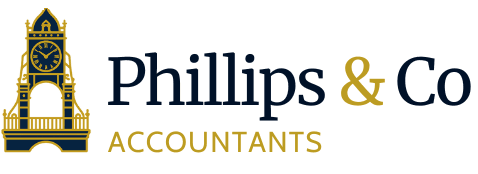Author: Phillips & Co Accountants, Chester
Date: 21 October, 2025
As part of our commitment to proactive tax planning, this blog provides important guidance for the 2025/26 tax year. The government has made significant changes to National Insurance (NI) that directly impact the most tax-efficient salary for company directors.
Here’s a clear breakdown of what has changed and the new strategies to consider for your payroll.
The Key Changes for 2025/26
The financial landscape for directors has shifted. The three key changes are:
- Employer’s NI Rate: This has increased to 15%.
- Employer’s NI Threshold (ST): This has been reduced to £5,000 per year. This is the point where the company starts paying the 15% tax.
- State Pension Limit (LEL): The salary needed to earn a “qualifying year” for your State Pension has risen to £6,500 per year.
The New Director’s Dilemma: Cost vs. Pension
This creates a new challenge for the first time. The threshold for paying NI (£5,000) is now lower than the threshold for earning a State Pension credit (£6,500).
This means the “free” pension credit strategy of previous years is no longer available. As a director, you now have a choice to make between keeping company costs at an absolute minimum or making a small investment to secure your pension.
Here are the two main strategies for this tax year:
Strategy 1: The “Zero-NI” Salary
Annual Salary: £5,000 (£416.67 per month)
Company NI Cost: £0
This is the highest salary you can take that incurs absolutely no National Insurance for either you or the company. It’s the lowest-cost option from a tax perspective.
The Drawback: At £5,000, your salary is below the Lower Earnings Limit. This means you would not get a qualifying year for your State Pension.
Strategy 2: The “Pension-Qualifying” Salary (Our Recommendation)
Annual Salary: £6,500 (£541.67 per month)
Company NI Cost: £225 (for the year)
With this strategy, you pay yourself at the Lower Earnings Limit, guaranteeing your State Pension credit for the year.
The Calculation: The company pays 15% NI on the part of the salary above the £5,000 threshold. (£6,500 – £5,000) = £1,500 £1,500 x 15% = £225
Our Recommendation: A £225 Investment in Your Future
For the majority of our clients, we are strongly recommending Strategy 2.
While no one wants to pay extra tax, this £225 should be seen as a smart investment. For this small, tax-deductible cost, the company is effectively “purchasing” a full qualifying year for your State Pension. Given the value of the State Pension in retirement, this is one of the most cost-effective investments a director can make.
What about the £12,570 Salary?
Paying a salary up to the personal allowance (£12,570) is now a very expensive option for a single director. Under the new 15% rate, this would trigger an Employer’s NI bill of £1,135.50 (£7,570 x 15%). It is far more tax-efficient to keep the salary at £6,500 and extract further profits as dividends.
Next Steps
The tax rules are constantly evolving. Our job is to stay ahead of these changes and ensure your finances are structured in the most efficient way.
If you have any questions about this new strategy or want to discuss how it applies to your personal circumstances, please get in touch. We are here to help.
Call/WhatsApp today on: 01244 220 062
If you’d like expert guidance, contact Phillips & Co Accountants Chester today.
Keep More, Stress Less
Disclaimer
The information contained in this blog is for general guidance only. It does not constitute professional advice and should not be relied upon as such. Always seek tailored advice from a qualified accountant regarding your specific circumstances.
